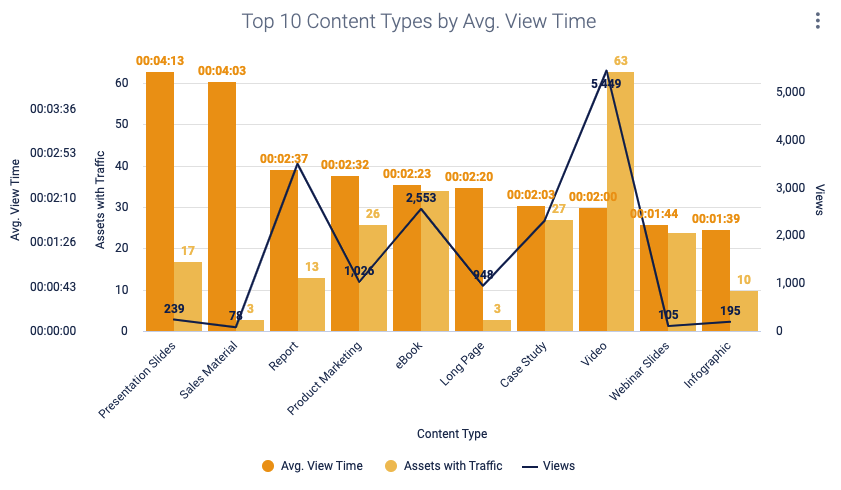
Next-Level Lead Nurture Building Manual for B2B Marketers
A B2B Lead Nurture Manual: Best Practices for the Perfect B2B Lead Nurture Flow
According to our 2023 Content Intelligence Report: The Rise of the Anonymous B2B Buyer, B2B content consumption has started to normalize when compared to the huge spike of content consumption during the pandemic. With that said, B2B content consumption is still higher than it was pre-pandemic, and the level is likely a ‘new normal’.
What does it all mean? B2B buyers are still dependent on content to guide them through their buyer journey. On top of that, they’ve come to expect the same micro-personalized experiences they enjoy on B2C platforms like Netflix, Amazon and Spotify. Don’t just take our word for it: according to Salesforce, 82% of business buyers want the same experience as when they’re buying for themselves.
Nurture programs need to adapt, and that means shifting the focus from pushing out campaigns to delivering rich and relevant content experiences. But how do you do that? We’re here to help.
Set the right pace by matching your nurture with prospects’ interests
Before you can assemble an effective nurture program, you need to know who you’re actually targeting — and adjust the pacing accordingly. Otherwise, your nurture might not deliver the right content at the right time. There are several ways to segment your nurture, depending on both the nature of your business as well as the data you have access to.
A few of the more common segments include:
- Solutions: If your company offers several solutions in different spaces, consider creating a separate nurture track for each one.
- Persona: If you sell into different levels or functions within an organization, it makes sense to assemble nurture streams for each persona.
- Funnel stage: As leads progress through the buyer’s journey, their content requirements will change. Segmenting your nurture by funnel stage helps prevent an information mismatch, like providing a detailed report before a prospect even knows who you are.
- Topic: If your prospects have previously signalled interest in a particular topic, build out a nurture track around relevant ideas or pain points.
- Industry: Complex B2B buying cycles demand in-depth, expert-level content, which can be challenging to deliver if you’re marketing products or services across multiple industries at once. Rather than treating them all the same, create industry-specific nurtures to ensure your leads receive content that’s actually applicable to them.
At PathFactory, we initially structured our nurture programs around funnel stage, creating specific content for MQLs, SQLs and SQOs. It looked something like this:
- TOFU content for pre-MQL
- MOFU content for MQL-SQL
- BOFU content for SQO
This was a relatively simple approach, but it worked. This year, however, we wanted to get really granular and deliver an even more personalized and relevant content experience to our leads. PathFactory’s solution consists of three main modules: Website Tools, Campaigns Tools and VEX (Virtual Events). Because these modules address very specific pain points for different types of marketers, we decided that each was deserving of its own funnel-based nurture stream. That’s 9 streams in total (so far), which may seem excessive, but it enables us to individualize our nurture program at a whole new level. We recommend this approach especially to multi-product companies.
However, determining how to segment your nurture program is only half the battle. You may have identified the right people, but how do you make sure they receive the right content, at the right time? Nothing will destroy your nurture program like bad timing — even if you’ve armed it with exceptional content and the best martech in existence.
Fortunately, there are tools available to help you. Using logic and automation, your nurture can deliver emails at different frequencies, depending on a prospect’s content consumption and engagement. At PathFactory, we combine data from Marketo (email opens and click-through rates) with more advanced reporting from our own tool, which tracks actual behavior around content consumption and engagement. This enables us to more accurately infer the level of interest from our leads — and their appetite for more. We then divide each nurture stream (9 at last count) into 3 different speed lanes:
Slow Lane
Who: Prospects who haven’t opened any emails or engaged with any content in 3 weeks
Nurture pace: 1 email every 3 weeks
Medium Lane
Who: Prospects who have opened and click an email within 3 weeks
Nurture pace: 1 email per week
Fast Lane
Who: Prospects who have meaningfully engagement with multiple pieces of content within a 3 week period
Nurture pace: 2 emails per week
This brings our grand total to 27 nurture streams! Now, at PathFactory, we determine speed lanes using our detailed content consumption data, which provides valuable insight into each prospect’s post-click journey (such as time spent on each content asset, order of assets viewed, time thresholds, etc.). However, you can also use speed lanes on a more basic level by looking at email open and click-through rates. Bonus: paying close attention to interest levels will also help improve your unsubscribe rate and email deliverability.
Pro Tip: Repeat the nurture cycle for prospects who didn’t make a purchase the first time around. Just be sure to change up your content (no one likes receiving the same email twice).
Determine the right content for your nurture
You’ve segmented your audience into different nurture tracks. Now it’s time to populate those tracks with content! This can feel like a daunting task, but the good news is that you’ve already done most of the groundwork. Here are the 3 steps we recommend to selecting your content:
1.) Take an inventory of your existing content
Inventory is a scary word, especially if your website hosts a vast library of content. Don’t panic. When building out a b2b lead nurture strategy, the goal of a content inventory isn’t to assemble an exhaustive list. It’s just to get a better idea of what you’re working with, so you can determine where your content belongs. At PathFactory, a content inventory might look like this:
- Video A: Introduction to PathFactory → TOFU stream
- Video B: Improved Analytics Announcement → BOFU stream
It’s really that simple. With solid segmentation in place and a basic familiarity with your existing content, you can easily funnel them into different streams.
Pro Tip: Taking inventory is a useful exercise, and not just when engineering a lead nurture program. It can also help you identify any content gaps.
2.) Use data to determine your best performing content
There’s no sense in promoting content in your nurture if it doesn’t generate engagement or pipeline. That’s why it’s important to dive into the data first and determine how your individual content assets are performing. The most important metric is average view times. Before selecting a piece of content to include, look at how long people have previously spent engaging with it. Content Intelligence from PathFactory informs us which specific type of content people are spending the most time on (i.e., blog posts, tutorials, e-books, etc.). This tells us what’s resonating, and we can direct our content production efforts accordingly.
3.) Map content to your chosen segmentation
Once you know what content you’re working with and how that content has previously performed, you can designate it accordingly. Although there’s no hard and fast rule, aim to select around 10 pieces of content for every nurture stream. You want enough content that your nurture can run comfortably in the background, but not so much that it’s unmanageable.
Pro Tip: You don’t have to limit your content assets to one particular nurture stream. Some pieces will resonate with different audiences and can be used across multiple streams. For instance, at PathFactory, we recently created a webinar that was applicable to a few different segments in our nurture. We tweaked the email copy so that each variation fit within its respective stream, but the content asset was the same.
Clear any roadblocks
Be on the lookout for any roadblocks which can interfere in your prospect’s content experience and ultimately disrupt your entire nurture.
Some of the biggies include:
- Inaccessible content: Forget about “useful” tools like form fills, which were designed for marketers, not buyers. To your prospects, these additional steps are irritating and cumbersome, especially when they just want to access your content. Instead, take a cue from Netflix and Spotify, who have normalized uninterrupted and self-directed content. You already know who you’re sending nurture emails to, so why slow down the journey when you can launch them straight into your content?
- Repeated content: Even the most basic marketing automation data will inform you which leads have opened and clicked through your emails. If you take it a step further with PathFactory content consumption data, you’ll also know which assets they actually read. With this level of information, there’s no excuse to send content to prospects they’ve already seen.
- Bad emails: Your emails should be user-friendly and follow best practices.
Friction Filled Journey
Frictionless Journey
Pro Tip: Combine your efforts towards nurture and “ad hoc” event campaigns. When these work together, you can scoop up immediate conversions during the event itself, and remaining attendees can be directed into the appropriate nurture track afterwards. Just be sure to sync up your nurtures with your event calendar so there’s no overlap.
Squeeze more engagement out of every click
In the Netflix era, content binging is the new norm, whether you’re researching enterprise software or watching Love is Blind. Yet most B2B marketers continue to deliver content in a slow, drip-like cadence, one asset at a time. This approach is remarkably similar to the heyday of primetime TV, when the networks would regulate when viewers could watch their favorite show.
There’s also the fact that B2B buyers are now consuming an average of 13 pieces of content during their purchase journey. With an old school nurture, this means not only capturing your prospect’s attention, but regaining it over and over again.
Alternatively, when you adapt your nurture to offer leads a “package” of content instead of a single piece at a time, you not only mimic the B2C experiences they’ve come to expect, you also make it easier for them to blitz research and accelerate through the funnel. In fact, through our own research at PathFactory, we’ve found that when supplementary content is offered to engaged prospects, 20% will exhibit binge behavior.
Establish an agile maintenance routine
When assembling a nurture program, there’s no such thing as “set it and forget it”. You need to constantly revisit, measure and report on your nurtures to make sure they deliver. Maybe there’s an email which isn’t working, or your prospects aren’t engaging with a particular content asset. If you see that a particular piece of content isn’t resonating with people, for example, you can remove it from your nurture stream entirely.
If your content is generating engagement once people actually get there, but your email open rate is still low, then your subject line is the problem. Take a look at the best performing subject lines you’ve previously used to identify shared qualities and establish best practices for a new email. If the click-through rate is low, evaluate the copy and banners from your best performing emails and use these as best practices instead. If both your open rate and click-through rate are low, start from scratch!
The good news is that nurtures aren’t set in stone, so there’s always room for adjustments.
Back to you
In order to build a successful, next-level nurture program, you need to adapt to the evolving needs of your prospects. Personalized, meaningful content has become a baseline expectation, not an added bonus. The best response as a B2B marketer is to ensure your nurtures are meticulously segmented, then populated with relevant, easily accessible content. Frequently measure, report and revisit your nurtures so you can respond quickly to any changes… then do it all again.









